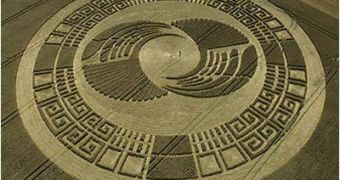At dawn, an increasing number of regular fields south of England become art, as their crop is tamped into complex patterns of rings, circles, squares and all the geometrical shapes you can think of. Crop circles have recently come into public attention, sparking many debates related mostly to their source.
Technically, crop circles aren't exactly circles, since all kinds of figures have been often spotted. Basically, they can be defined as geometrical patterns that occur in the fields by tamping down some portions of the crops and leaving the rest intact. They range from simple rings or circles to sophisticated interconnections of complicated shapes. Such circles appear in various field types, like wheat, rice, corn, oats, barley, rye, oil-seed rape, tobacco, and even weed fields. Most of the crop circles are located in low areas near steep hills, which is an argument for their wind creation theory. The crop circle "season" coincides with that of crop growing, running from April to September and the circles are always formed during nighttime, in order to hide their makers from sight.
First mention of such an event dates from the 1500s, while "Nature" first reported its occurrence in an issue from 1880. Only a century later the phenomenon gained public attention, most part of the circles being found in southern England, especially in counties like Hampshire and Wiltshire. Many more have been located close to Avebury or Stonehenge, England's two large stone monuments containing mystical sites. Crop circles are not only found in England or Europe; they have also been spotted in the United States, Canada, Japan, Australia, India and the rest of the world.
Some of the more complicated patterns are obviously based on mathematical equations, showing that, whoever their creators are, they have vast knowledge of Euclidean geometry. Astronomer and ex-professor Gerald S. Hawkins from Boston University studied them and discovered that the positions of their geometric shapes were laid in place based on certain specific numerical relationships. In one of them, which had an outer circle and an inner one, the area of the outer circle was precisely 4 times that of the inner one.
People interested in the crop circle phenomenon have called themselves "cereologists," borrowing their name from Ceres, the Roman goddess of agriculture, or "croppies." In order to investigate the occurrence of the event, they talk to people who live nearby and presumed eye-witnesses, and they record location and weather conditions. Then they use complex techniques like X-ray diffraction analysis in order to determine the composition of the affected crops and read electromagnetic energy indications inside and near the circles. Finally, the overall model design is being studied (some resemble ancient hieroglyphs or other mystical symbols).
The theories surrounding the phenomenon link it to the work of aliens, nature or humans. UFO-enthusiasts claim that the circles are the imprinted shapes of their spacecrafts or even messages left on purpose by extraterrestrials for communication purposes. But aliens would make themselves visible if they tried to speak with us, or they would choose better methods of issuing communication. Some other theorists blame them on airplanes or helicopters, but the attempts of recreating circles based on that speculation utterly failed.
Others believe it's the force of small currents of swirling winds (vortices) that create such complex patterns as they charge up with energy and force bursts of air downwards, flattening the crops. But how can the winds know mathematics and manifest themselves only at night? Earth's electromagnetic radiation, another source that has been proposed, also suffers from the same flaws.
The final, most obvious theory places crop circle creation in the skilled hands of humans. Doug Bower and Dave Chorley, or "Doug and Dave" as they're better known, claimed in 1991 that they were responsible for the event. When they were asked to prove it, they created a perfect example of a fairly complicated circle. But the phenomenon is too old and widely spread for them to be the only ones. Colin Andrews, cereologist and author of the "Circular Evidence" book, claims that while 80% of the crop circles are man-made, the remaining 20% must be the work of a "higher force." Indeed, such circles are easy to make if one has the right tools and enough imagination.

 14 DAY TRIAL //
14 DAY TRIAL //